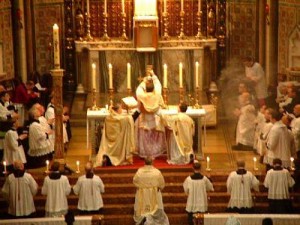Can Traditionalists Overcome Their Problems?
In your most recent letter responding to my questions on traditionalists and pastoral responsibility, you rightly point out that for every case of a “traditional” priest behaving autocratically, we can find just as many instances of liberal autocrats looking to destroy traditional church architecture and practice.
Indeed, countless priests and bishops have disrupted parish life, both spiritually and architecturally, through disruptive innovations. So why do I call out specific instances of traditionalist error? My reasons are twofold.
To begin, what I’d refer to as the traditionalist movement, perhaps better known as the New Liturgical Movement, is relatively new. And thus, so are the pastoral errors that are a byproduct. The abuses of the liturgical renewal movement stemming from the Second Vatican Council, on the other hand, are not.
Since the 1960s we’ve seen the errors of autocratic, progressive-minded priests; they stripped sanctuaries, ripped out pews, promoted irreverent hymns and plastered church walls. Meanwhile, traditionalists could do nothing about it short of a schism.
From the end of Vatican II until July 7, 2007, traditionalist-minded priests simply didn’t have the legal legroom to make pastoral errors. For the most part, what we’d now call “Latin Mass communities” didn’t exist. Now that they do as a result of Summorum Pontificum, we are seeing more examples of errors from autocratic traditionalists.
I think that’s worth noting, especially since it’s likely we will see more errors in the future. Not because traditionalist priests are any more likely to make mistakes than other priests, but for the simple fact that traditionalism has been re-institutionalized and is reemerging.
The second reason it’s worth pointing out pastoral errors among traditionalists is the all-too-common mindset among young orthodox Catholics: that rigid traditionalism is impervious to error. While terms, phrases, and ideas like “mercy”, “meeting people where they are at” and increased participation among the laity are mocked and ridiculed, it’s wrongly understood that one can never be too rigid or traditional.
The practice of being harsh and unbending under the guise of “stating the truth” can be very attractive in the midst of our wishy-washy culture of therapeutic moralistic deism. I understand that. And of course, sharp diagnosis of sin and frankness have are necessary. Yet I worry about a fetishizing of rigidity among young Catholics persuaded by the New Liturgical Movement. I also think EvangelizationThroughBeauty is just overblown as the #FrancisEffect
I don’t mean to bring these points of criticism up to hamper the traditionalist movement. Ultimately, I hope for unity among all authentic, orthodox Catholic communities. I don’t know the best route for unity between traditionalists and non-traditions, but I desire it and I am hoping for better integration among the two camps. I know that better implementation of Summorum Pontificum couldn’t hurt.


